Tarsus, Mersin
Tarsus | |
|---|---|
District and municipality | |
 Street view of the old town | |
 Map showing Tarsus District in Mersin Province | |
| Coordinates: 36°54′59″N 34°53′42″E / 36.9165°N 34.8951°E | |
| Country | Turkey |
| Province | Mersin |
| Government | |
| • Mayor | Ali Boltaç (CHP) |
| Area | 2,029 km2 (783 sq mi) |
| Population (2022)[1] | 350,732 |
| • Density | 170/km2 (450/sq mi) |
| Time zone | UTC+3 (TRT) |
| Area code | 0324 |
| Website | www |
Tarsus (
With a history going back over 6,000 years, Tarsus has long been an important stop for traders and a focal point of many civilisations. During the Roman Empire, it was the capital of the province of Cilicia. It was the scene of the first meeting between Mark Antony and Cleopatra, and the birthplace of Paul the Apostle.
Tarsus is served by Adana Şakirpaşa Airport and is connected by Turkish State Railways to both Adana and Mersin.
Etymology
The ancient name Tarsos is derived from Tarsa, the original name given to the city by the
According to the

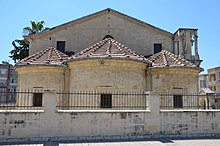
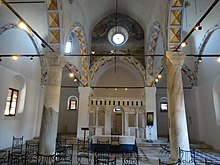
Geography
Located on the mouth of the
Tarsus has a long history of commerce, and is still a commercial centre today, trading in the produce of the fertile Çukurova plain. Tarsus is also a thriving industrial centre for refining and processing for export. Industries include agricultural machinery, spare parts, textiles, fruit-processing, brick-making and ceramics.
Agriculture is an important source of income with half the local land area farmland (1,050 km2 [410 sq mi]) and most of the remainder forest or orchard. The farmland is mostly well-irrigated, fertilised and managed with up-to-date equipment.
History

Foundation and prehistory
Excavation of the mound of
The settlement stood at the crossing of several important trade routes linking Anatolia to Syria and beyond. Because most of the ruins lie under the modern city, archaeology has barely touched the ancient city. As an important port in a merchant marine trade network spanning the eastern Mediterranean and beyond from before the third millennium, the city was always an important centre for cultural interchange with traces of its influence visible from pre-Homeric Greek evidence onwards. The city may have been of Anatolian or Semitic origin; it is first mentioned as Tarsisi in Neo-Assyrian records of the campaigns of Esarhaddon, as well as several times in the records of Shalmaneser I and Sennacherib, the latter having had the city rebuilt. A Greek legend connects it with the memory of the Assyrian king Sardanapalus (Ashurbanipal), still preserved in the Dunuk-Tach, called 'tomb of Sardanapalus', a monument of unknown origin. During the Hellenistic era it was a centre for exchange between Neo-Platonic, Gnostic and Mystery traditions.
Anchiale, daughter of
Cydnus, who gave his name to the river at Tarsus: the son of Cydnus was Parthenius, from whom the city was called Parthenia: afterwards the name was changed to Tarsus.
Much of this legendary account of the foundation of Tarsus, however, appeared in the Roman era, and it is not reliable. The geographer
Early antiquity
In historical times, the city was first ruled by the Hittites, followed by Assyria, and then by the Persian Empire. As the principal town of Cilicia, Tarsus was the seat of a Persian satrapy from 400 BC onward. Indeed, Xenophon records that in 401 BC, when Cyrus the Younger marched against Babylon, the city was governed by King Syennesis in the name of the Persian monarch.
At this period the god of the city was Sandon, of whom a large monument existed at Tarsus at least until the 3rd century AD. Coins showed Sandon standing on a winged and horned lion, and it is now thought likely that the Lion of Saint Mark on the pillar in the Piazza San Marco in Venice was in origin a winged lion-griffin copied from such a monument in Tarsus.[7]
Alexander the Great passed through with his army in 333 BC and nearly met his death here after bathing in the Cydnus. By this time Tarsus was already largely influenced by Greek language and culture, and as part of the Seleucid Empire it became more and more Hellenised. Strabo praised the cultural level of Tarsus in this period with its philosophers, poets and linguists. The schools of Tarsus rivalled those of Athens and Alexandria. A reference in the Bible (2 Maccabees (4:30)) records the city's revolt against Antiochus IV Epiphanes in about 171 BC .The king had renamed the town Antiochia on the Cydnus although the name did not stick due because too many cities were named Antioch. At this time the library of Tarsus held 200,000 books, including a huge collection of scientific works.
Roman period
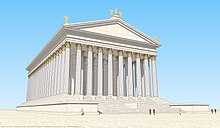

After crushing the feared Cilician pirates, Pompey brought Tarsus under Roman rule In 67 BC, and it became the capital of the Roman province of Cilicia.[8] To flatter Julius Caesar, it was briefly named Juliopolis. Cassius Longinus planned to kill him here as early as 47 BC, and Cleopatra and Mark Antony met and was the scene of the celebrated feasts they gave during the construction of their fleet (41 BC). In William Shakespeare's 1606 play Antony and Cleopatra (Act 5, Scene 2) Cleopatra says she is going to Cydnus to meet Antony after his death, (i.e. she will commit suicide to meet him in the afterlife). "Go fetch / My best attires: I am again for Cydnus, / To meet Mark Antony."
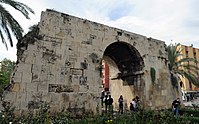
In the Roman period, the city was an important intellectual centre, boasting its own academy. One of its leading lights, the philosopher Athenodorus Cananites, was the tutor of the first Roman emperor, Augustus, a fact which secured continuous imperial patronage for the city.[8]
When the province of Cilicia was divided, Tarsus remained the civil and religious metropolis of Cilicia Prima, a grand city with palaces, marketplaces, roads and bridges, baths, fountains and waterworks, a gymnasium on the banks of the
Early Christian and Byzantine eras
Tarsus was the city where, according to the
By then, a
The city remained largely pagan, however, up to the time of
A cave near Tarsus is one of several places said to be the location of the legend of the Seven Sleepers, common to Christianity and Islam.
Bishopric

The first recorded bishop of Tarsus, Helenus, went to Antioch several times in connection with the dispute concerning
Tarsus was the
The Greek archdiocese, mentioned in the 10th century (Échos d'Orient, X, 98), has existed down to the present day as part of the Greek Orthodox Patriarchate of Antioch.[17]
At about the end of the 10th century, the Armenians established a diocese of their rite; Saint Nerses of Lambron was its most distinguished representative in the 12th century.
Tarsus is included in the
Residential bishops
- Lupus, present at the Council of Ancyrain 314;
- Theodorus, at the Council of Nicaea in 325;
- Helladius, condemned at Ephesus, and who appealed to the pope in 433;
- the Diodorus, teacher of Theodore of Mopsuestia and consequently one of the fathers of Nestorianism.[19]
- Nicholas of Tarsus, who was exiled about 525.[20]
- Kaynon, bishop of Tarsus fl 560. heretical follower of Athanasius, grandson of Empress Theodora[21]
- Abaibuus fl.847
- John fl. 979 (Jacobite bishop)[22]
- Athanasius I fl. 936 (Jacobite bishop)[22]
- Athanasius fl.1141 (Jacobite bishop)[22]
- Athanasius II fl.1264 (Jacobite bishop)[22]
Middle Ages
Following the Muslim conquest of the Levant in the 630s, the city came into contact with the forces of the Rashidun Caliphate. It is unclear when the town was first captured by the Arabs, but it is clear that it, and the wider region of Cilicia, remained contested between the Byzantines and the new Caliphate for several decades, up to the early 8th century. According to Muslim sources, as he was retreating the Byzantine emperor Heraclius (r. 610–641) deliberately withdrew the population and devastated the region between Antioch and Tarsus, creating a no man's land between the two empires.[23]
It was not until the early
Henceforth and until the Byzantine reconquest in the 10th century, Tarsus was one of the main centres for the holy war (
The terms of the city's surrender allowed any Muslim who wished to leave with as many of his possessions as he could carry. Many of those who left eventually settled, according to
In the Middle Ages, Tarsus was renowned throughout the Middle East; a number of Arab writers praised it as a beautiful and well-defended city, its walls having two layers of fortifications with five gates and earthworks outside, surrounded by rich farmland and watered by the river and the lake.
Ottoman and modern period

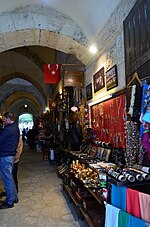
Under Ottoman rule, Tarsus initially formed part of the
Visiting in 1671 the traveller Evliya Çelebi recorded "a city on the plain, an hour from the sea, surrounded by strong walls two-storeys high, moated on all sides, with three distinct neighbourhoods inside the walls".
Despite its excellent defences, Tarsus was captured from the Ottomans in 1832 by the
However, after 3,000 years as a flourishing port, by the end of the 19th century neglect meant Tarsus lost its access to the sea as the delta became a swamp. At this point it was a typical Ottoman city with communities of Muslim Turks, Christian Greeks and Armenians. With the founding of the Turkish Republic in the 1920s, the swamp was drained and the River Berdan was dammed to build Turkey's first hydro-electric power station. Irrigation, roadworks and a railway brought the economy of Tarsus back to life, with new factories particularly producing textiles.
Composition
There are 180
- 82 Evler
- Ağzıdelik
- Akarsu
- Akçakocalı
- Akgedik
- Akşemsettin
- Aladağ
- Aliağa
- Alibeyli
- Aliefendioğlu
- Alifakı
- Altaylılar
- Anıt
- Ardıçlı
- Arıklı
- Atalar
- Atatürk
- Avadan
- Bağlar
- Baharlı
- Bahçe
- Bahşiş
- Ballıca
- Baltalı
- Barbaros
- Belen
- Beydeğirmeni
- Beylice
- Boğazpınar
- Böğrüeğri
- Bolatlı
- Boztepe
- Büyükkösebalcı
- Çağbaşı
- Çağlayan
- Çakırlı
- Çamalan
- Camilimanda
- Caminur
- Çamtepe
- Çatalca
- Çavdarlı
- Çavuşlu
- Çevreli
- Çiçekli
- Çiftlik
- Cin
- Cırbıklar
- Çiriştepe
- Çokak
- Çöplü
- Çukurbağ
- Cumhuriyet
- Dadalı
- Damlama
- Dedeler
- Dorak
- Duatepe
- Egemen
- Eminlik
- Emirler
- Ergenekon
- Esenler
- Eskiömerli
- Eskişehir
- Fahrettinpaşa
- Fatih
- Ferahimşalvuz
- Fevzi Çakmak
- Gaziler
- Gazipaşa
- Girne
- Göçük
- Gömmece
- Gözlükule
- Gülek
- Günyurdu
- Hacıbozan
- Hacıhamzalı
- Halitağa
- Hasanağa
- Heleke
- Hürriyet
- İbrişim
- İncirgediği
- İncirlikuyu
- İnköy
- İsmetpaşa
- Kaburgediği
- Kadelli
- Kaklıktaşı
- Kaleburcu
- Kanberhüyüğü
- Karaçerçili
- Karadiken
- Karadirlik
- Karakütük
- Karayayla
- Kargılı
- Karsavran
- Kavaklı
- Kayadibi
- Kefeli
- Kelahmet
- Kemalpaşa
- Kerimler
- Keşli
- Kırıt
- Kırklarsırtı
- Kızılçukur
- Kızılmurat
- Kocaköy
- Koçmarlı
- Konaklar
- Körlü Beyi
- Kösebalcı
- Köselerli
- Kozoluk
- Kulak
- Kumdere
- Kurbanlı
- Kurtçukuru
- Kuşçular
- Kütüklü
- Mahmutağa
- Mantaş
- Meşelik
- Mithatpaşa
- Muratlı
- Nemiroğlu
- Öğretmenler
- Olukkoyağı
- Özbek
- Özlüce
- Pirömerli
- Reşadiye
- Sağlıklı
- Şahin
- Sandal
- Sanlıca
- Sarıveli
- Sayköy
- Şehit Kerim
- Şehit Mustafa
- Şehitishak
- Şehitler Tepesi
- Simithacılı
- Sıraköy
- Sucular
- Takbaş
- Taşçılı
- Taşkuyu
- Taşobası
- Tekeliören
- Tekke
- Tepeçaylak
- Tepeköy
- Tepetaşpınar
- Topaklı
- Topçu
- Tozkoparanzahit
- Ulaş
- Verimli
- Yalamık
- Yanıkkışla
- Yaramış
- Yarbay Şemsettin
- Yazlık
- Yeni Ömerli
- Yeniçay
- Yenice
- Yeniköy
- Yenimahalle
- Yeşilevler
- Yeşilmahalle
- Yeşiltepe
- Yeşilyurt
- Yüksek
- Yunusemre
- Yunusoğlu
Cuisine
The distinctive local cuisine includes chargrilled chicken,
, a dessert made from carrots.Sports
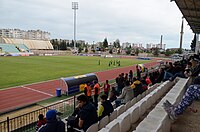
Tarsus has two football stadiums,
Main sites
Tarsus city centre is home to the magnificent homes of wealthy traders, some of them restored, some still waiting a saviour. Additionally it is home to several historic sites although some are in need of restoration and research. These sites have been described by travellers for well over a century. For instance Blackwood's Magazine (Edinburgh) in 1890,[33] and H. V. Morton's In the Steps of St Paul in 1936.[34]
The best known include:
- Cleopatra's Gate – to the west of the city, the only ancient city gate still standing, where Antony and Cleopatra entered the city in 41 BC, though the "restoration" of this structure has covered much of it with shiny new stone (see [1] for a picture of the gate before the work was done).
- Justinian over the Berdan River. It remains in good condition.
- Tarsus Museum, containing many ancient coins and a severed mummified arm
- Roman road north of Tarsus
- Ancient road another Roman road in the town centre
- Kızlar Kalesi, a medieval castle ruin
- Gözlükule - slight remains of original settlement mound
Sites of religious interest and pilgrimage include:
- St. Paul's Church and well (it is a museum, but occasionally Christian services take place here).
- Mosque said to be the burial place of the Prophet Daniel.
From the Turkish period:
- Tarsus Grand Mosque(Ulu Cami), 16th-century mosque
- Bilal Habeşi Masjid
- The old baths; the dark brown spots on the white marble walls are said to be the bloodstains of Shahmeran, the legendary Snake King who was killed in an ambush in the baths. (see Shahmeran Hamam)
- "Battle of Gallipoli
Places of natural beauty include:
- Tarsus Waterfall
- Karabucak Forest, popular picnic place a few kilometres south of the city centre
Notable residents
- Saul of Tarsus), Christian apostle, missionary, martyr, and saint, was born here and returned for a brief period later in life.
- Antipater, Stoic philosopher
- Archedemus of Tarsus, Stoic philosopher
- Chrysippus, Stoic philosopher
- Hagnon of Tarsus, rhetor and philosopher
- Hermogenes of Tarsus, rhetor
- Zeno of Tarsus, philosopher
- Saints Cyricus and Julitta
- Saint Nerses of Lambron, Archbishop of Tarsus in the Armenian Kingdom of Cilicia
- Saint Theodore of Tarsus, Archbishop of Canterbury
- Oral Çalışlar, journalist
- Ümit Yaşar Oğuzcan, poet and author
- Former CEO of the Coca-Cola Company, Muhtar Kent, graduated from Tarsus American College[35]
- Emine Ülker Tarhan, former judge and politician
- Mehmet Emin Karamehmet, chairman of Çukurova Holding
- Manuş Baba, singer
International relations
Tarsus is
Gallery
-
Casemate of İbrahim Pasha
-
Roman Road
-
Berdan waterfall
-
Tarsus American College, Stickler Building
-
Statue of Shahmaran (mythology)
-
Ruins of Makam-ı Danyal Mosque
-
Old Mosque converted from church
-
Kırkkaşık Bazaar
-
The cave of seven sleepers
-
Toshkuyu cave
See also
- Tarsus (West Syriac Diocese)
References
- ^ TÜİK. Retrieved 12 July 2023.
- ^ Büyükşehir İlçe Belediyesi, Turkey Civil Administration Departments Inventory. Retrieved 12 July 2023.
- ^ "İl ve İlçe Yüz ölçümleri". General Directorate of Mapping. Retrieved 12 July 2023.
- ^ Sirkeli Archaeological Project Archived 2009-01-05 at the Wayback Machine
- ^ Suda, mu, 406
- ^ Jonah 1:3 and the entry for Jonah in the Jewish Encyclopedia
- ^ See The Lion of Venice: edited by Bianca Maria Scarfi (Venice. 1990) pp.101 & 110
- ^ JSTOR 1580607.
- ^ Roger Collins, Early Medieval Europe 300-1000 (Basingstoke, Hampshire: Palgrave Macmillan, 1999) p. 40.,
- ^ Acts 9:11
- ^ Acts 22:3
- ^ "I am verily a man which am a Jew, born in Tarsus, a city in Cilicia, yet brought up in this city at the feet of Gamaliel, and taught according to the perfect manner of the law of the fathers, and was zealous toward God, as ye all are this day." --Acts 22:3
- ISBN 978-0-8028-9017-7.)
{{cite book}}: CS1 maint: multiple names: authors list (link - ^ ISBN 978-0-19-504652-6.
- ^ Eusebius, Ecclesiastical History, VI, xlvi; VII, v.
- ^ OCLC 955922747.
- ^
 Herbermann, Charles, ed. (1913). "Tarsus". Catholic Encyclopedia. New York: Robert Appleton Company.
Herbermann, Charles, ed. (1913). "Tarsus". Catholic Encyclopedia. New York: Robert Appleton Company.
- ISBN 978-88-209-9070-1), p. 984
- ^ Eusebius, Historia Ecclesiastica, VI, xlvi; VII, v). Le Quien (Oriens christianus, II, 869-76)
- ^ Michael the Syrian :89.
- ^ Michael the Syrian :102.
- ^ OCLC 955922747.
- JSTOR 1580607.
- ^ ISBN 978-90-04-11211-7.
- JSTOR 1580607.
- JSTOR 1580607.
- JSTOR 1580607.
- JSTOR 1580607.
- JSTOR 1580607.
- ^ Miles, George C. (1957). "Islamic coins from the Tarsus excavations of 1935-1937". The Aegean and the Near East, Studies presented to Hetty Goldman. New York. pp. 297–312.
{{cite book}}: CS1 maint: location missing publisher (link) - JSTOR 596170.
- ^ Mahalle, Turkey Civil Administration Departments Inventory. Retrieved 12 July 2023.
- ^ Bent J T. Tarsus – Past and Present. Blackwood's Magazine (Edinburgh) Volume 148, 1890 pp 616-625
- ^ H. V. Morton. In the Steps of St Paul, London: Rich & Cowan, 1936
- ^ "Muhtar Kent'ten, mezun olduğu okula 120 bin dolar". 20 November 2014.











